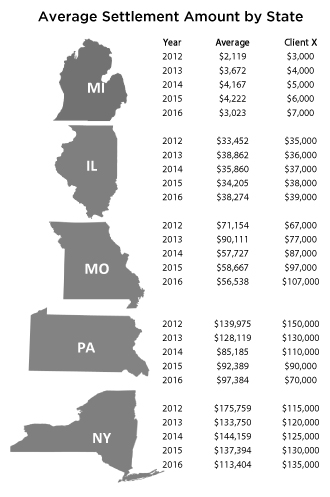

Last year, we blogged about the incidence of mesothelioma in the general population and how it has been exceeding the predictions of the Nicholson study. Then we continued this discussion with a blog about the existence of “background” mesotheliomas not caused by exposure to asbestos. In this post, we will dive into the importance of usefully forecasting asbestos liabilities by combining industry and company-specific experience at the local level with epidemiological studies and actuarial forecasting techniques.
Forecasting asbestos liabilities is critical for asbestos defendants to effectively manage litigation strategy, meet auditing requirements, maximize available insurance assets, and manage related cashflow. For the majority of defendants, mesothelioma claims drive the value of the litigation. While any given forecast contains many elements, each forecast answers the following basic questions:
How many people will sue the defendant with mesothelioma claims?
Out of those who sue, how many claims will be dismissed without payment?
Out of those claims that will be paid, how much will the defendant ultimately pay?
How much will it cost to defend all of the above?
Even small changes in the assumptions of any of the items listed above can have a dramatic impact on the size of the resulting estimate. The traditional actuarial approach uses relatively simple models applied to historic averages, but frequently this approach produces estimates that bear little resemblance to experience. That’s because asbestos litigation is a defendant-specific, local problem. As our recently published 2017 Asbestos Litigation report shows, while filings are continuing at a slight decreasing trend, they remain highly concentrated in certain jurisdictions and with certain plaintiff firms, and they remain a serious issue for defendants facing such lawsuits. Often, statistical models that do not incorporate what’s really happening “on the ground” with the specific defendant will miss the mark. Each forecast must answer the question “What are the relevant facts for THIS defendant?”
Given the aggressive (and effective) advertising efforts of plaintiff counsel, it’s not unreasonable to assume that nearly anyone diagnosed with mesothelioma in the future will consider filing a lawsuit. This makes the pool of potential mesothelioma claimants anyone who might be diagnosed with mesothelioma in the future. Epidemiological models such as Nicholson[1], Stallard[2] and Price[3] forecast the total incidence of mesothelioma, i.e. the number of people expected to get the disease. A typical forecasting approach is to determine a defendant’s propensity to be sued. In other words, of all the people who are diagnosed with mesothelioma next year, what percent will choose to file a claim against a particular defendant? That percent is then applied to the total estimated future incidences as predicted by one of the epidemiological models.
Historic filings can be used to calculate the percent of total claims against a particular defendant given an assumed denominator, or total number of claims, but whether the resulting number reflects the future propensity of a defendant to be sued should be thoroughly vetted. Certain factors that could make this number increase or decrease cannot be easily measured using historic data alone. Things like the bankruptcy of other defendants in the same industry that were previously named with the defendant, corporate restructuring of related defendants, mass filings by certain plaintiff firms, and litigation reform in prominent jurisdictions will impact the estimations. Reviewing filing trends by jurisdiction and plaintiff firm for a defendant, then comparing to all filings, can help determine if a particular defendant can expect an increased or decreased propensity to be sued.
Dismissal rates vary by jurisdiction and plaintiff firm. Once there is an estimate of total future filings for a defendant, a resolutions rate and expected settlement values are applied to estimate a future liability stream. But again, looking at historic dismissal rates is more than just arithmetic. I often see a simple dismissal rate of the number of cases filed and resolved during a time period used for an estimate of all future cases to be dismissed without pay. A deeper dive by file year, by plaintiff firm, and by jurisdiction is required for many defendants. The claims dismissed this year may have been filed many years ago and may not be reflective of the claims being filed today. KCIC always calculates a full matrix of resolution by file year, by disease, and frequently by jurisdiction and plaintiff firm. An analysis of how the defendant compares to the trends observed in all filings can be beneficial, as well. Is this defendant being named by the same high-volume plaintiff firms naming over 100 defendants on average, or are they being named in a seemingly more targeted way?
Determining the applicable mesothelioma settlement value to apply to the remaining, non-dismissed mesothelioma claims is extremely fact-intensive and defendant-specific. Values vary by jurisdiction and plaintiff firm. A detailed review of settlements by plaintiff firm, jurisdiction, year and disease is required to verify that the settlement value considered in the forecast is representative of reality.


When estimating future defense costs associated with asbestos litigation, often a ratio of historic indemnity to defense dollars is carried forward. This may not be a good predictor, since setting up a national network of counsel is sometimes expensive. But once in place, there are certain economies of scale that kick in and eventually defense costs will probably remain fairly steady. In addition, all alternative defense arrangements, such as caps in total spend or rate increases, need to be considered.
There are many other questions to be asked and answered with a combination of data analysis and discussions with counsel as part of a forecast. How long does it typically take to resolve a claim for this defendant, and does it differ by factors such as plaintiff counsel or jurisdiction? What was the nature of the underlying product or exposure that brings this defendant into ligation, including how long ago could the last confirmed exposure have been? Do the average age and dates of first exposure of the current claimants reflect the known product history and, if not, why might that be? Is the science supporting, or not supporting, their future involvement in this litigation? Epidemiology studies and the supporting science increasingly show that people are going to continue to get mesothelioma for the foreseeable future; will defendants continue paying claims 30, 40 or even 50 years after their products were taken off the market?
While our data show that filings seem to be trending down, albeit very slowly, many asbestos defendants still expect to be involved in this litigation for many years to come. A comprehensive forecasting analysis can help a company navigate the future successfully by helping to manage cash flow, evaluate defense strategies, and ultimately thrive — despite the strain of asbestos litigation.
Notes:
[1] “Occupational Exposure to Asbestos: Population at Risk and Projected Mortality 1980-2030” by Messrs. Nicholson, Perkel and Selikoff, published in the American Journal of Industrial Medicine in 1982.
[2] Eric Stallard, A.S.A., M.A.A.A, is a research Professor of Demographic Studies at Duke University who has published many articles and a book on forecasting asbestos-related personal injury claims including “PRODUCT LIABILITY FORECASTING FOR ASBESTOS-RELATED PERSONAL INJURY CLAIMS: A MULTIDISCIPLINARY APPROACH”, a paper presented at the National Institute on Aging Conference: Demography and Epidemiology: Frontiers in Population Health and Aging. Washington, DC, February 9-10, 2001 and Forecasting Product Liability Claims
Epidemiology and Modeling in the Manville Asbestos Case, 2004 Springer-Verlag NY, LLC.
[3] “Mesothelioma Trends in the United States: An Update Based on Surveillance, Epidemiology, and End Results Program Data for 1973 through 2003”, by Bertram Price and Adam Ware, published in the American Journal of Epidemiology, January 15, 2004.
Never miss a post. Get Risky Business tips and insights delivered right to your inbox.